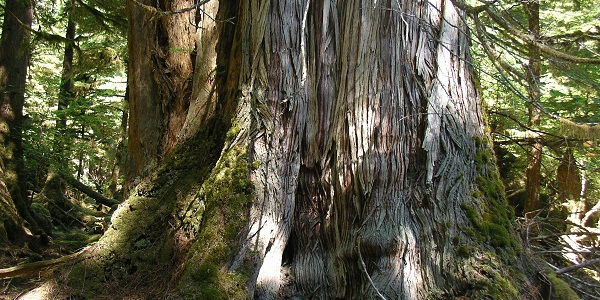Whither the Yellow Cedar?
posted by: Administrator, March 16, 2012 at 12pm
The sad irony of a tree freezing to death in a warming climate. How to stop it
New research is showing that Yellow Cedar, one of the characteristic tree species found in the Great Bear Rainforest of B.C., is disappearing in many areas because of the impacts of global warming. Ironically, they’re freezing to death.
Normally, the vulnerable roots of the yellow cedar are blanketed with a protective layer of snow during winter. But as global warming advances and snow becomes scarce, more yellow cedars are lacking this protective blanket and are exposed to freezing soil. It’s no longer just too much logging that is threatening B.C.‘s coastal old-growth forest.
Coastal temperate rainforests are one of the rarest ecosystems on earth, covering less than one per cent of the total land mass of the planet. The Great Bear Rainforest is one of the largest intact temperate rainforests in the world, and is home to species that don’t exist anywhere else, like the Spirit or Kermode bear. To protect the Yellow Cedar and all of the species that call the Great Bear Rainforest home, more large intact areas need to be protected to deal with the double threat of habitat loss and climate change.
According to the International Panel on Climate Change, globally around 20-30 per cent of all species will be at an increased risk of extinction if global average warming exceeds 1.5-2.5 degrees Celsius by 2100 (and 40-70 per cent of species if temperature increase exceeds 3.5 degrees Celsius).
In many parts of the world species were already at risk of extinction before we entered the era of man-made global warming. For example, in our province, as a result of the footprint of human activities, 43 per cent of our animals and plants species are considered at risk.

Photo Credit: Tom Green
Survival needs space
With or without global warming, changes to the ways we use land and ocean ecosystems are urgent to maintain the web of life and the multiple services of animals and plants without which human society cannot exist. Compared to the fossil record, extinctions have already reached a rate 100 to 1,000 times higher than before humans entered the stage. It is the combination of decades of habitat destruction with climate change that poses the ultimate threat for biodiversity as we know it, and to which biologists refer as the sixth mass extinction event (the last one occurred 65 million years ago).
Still, healthy, undisturbed forests are more resilient and less vulnerable to global warming, so leaving enough forest intact will help to maintain species like yellow cedar in some areas of the coast. But adaptation to climate change also means that many species have to migrate, for example south, north or into higher altitudes. This is only possible if intact forests are not too small and fragmented or species could become trapped as the climate shifts around them.
To protect as many species as possible, we have to take two types of action immediately: save large, intact natural ecosystems and phase out fossil fuels as quickly as possible.
The Great Bear Rainforest Agreements announced on Feb. 7, 2006 by the province, First Nations, logging companies and environmental organizations have the goal to achieve healthy communities and healthy rainforests. The key scientific recommendation is to set aside 70 per cent of the natural level of old growth forests. This level of conservation will not only protect the Great Bear Rainforest from traditional threats, such as unsustainable logging, but also give plants and animals a fighting chance to adapt to global warming (so long as we also get on with reducing our dependence on fossil fuels). The outstanding measures to achieve healthy communities and healthy ecosystems can be implemented within a year, by March 31, 2013.
For the yellow cedar, and many other species, it’s critical that the province follows through on the outstanding steps required under the Great Bear Rainforest Agreements. Fully implementing this model will allow coastal communities and ecosystems to be better prepared and more resilient in an era of climate change. With global warming, time isn’t on the side of the yellow cedar. But if we act quickly, we’ll give it the best chance it’s got.
Visit www.takeittaller.ca to tell the provincial government to “Take It Taller” for one of the last rainforests of its kind, the Great Bear Rainforest.
Jens Wieting is a coastal forest campaigner for Sierra Club BC.
Originally posted at: http://thetyee.ca/Opinion/2012/03/16/BC-Yellow-Cedar/